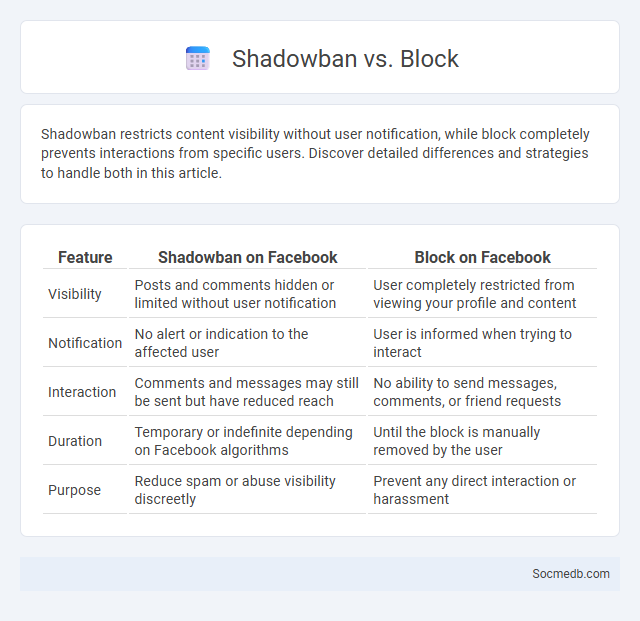
Photo illustration: Shadowban vs Block
Shadowban restricts content visibility without user notification, while block completely prevents interactions from specific users. Discover detailed differences and strategies to handle both in this article.
Table of Comparison
| Feature | Shadowban on Facebook | Block on Facebook |
|---|---|---|
| Visibility | Posts and comments hidden or limited without user notification | User completely restricted from viewing your profile and content |
| Notification | No alert or indication to the affected user | User is informed when trying to interact |
| Interaction | Comments and messages may still be sent but have reduced reach | No ability to send messages, comments, or friend requests |
| Duration | Temporary or indefinite depending on Facebook algorithms | Until the block is manually removed by the user |
| Purpose | Reduce spam or abuse visibility discreetly | Prevent any direct interaction or harassment |
Understanding Shadowban: Definition and Impact
Shadowban refers to the covert restriction of a user's content visibility on social media platforms without notification, significantly reducing engagement and reach. This practice affects influencers, businesses, and everyday users by limiting exposure while maintaining the appearance of normal account activity. Understanding shadowban mechanisms is crucial for optimizing content strategies and maintaining organic audience growth.
What Does ‘Block’ Mean on Social Platforms?
On social media, 'block' refers to a privacy feature that prevents a specific user from interacting with your profile, posts, and messages. When you block someone, they cannot follow you, send direct messages, or view your content, ensuring personal control over your online presence. This function enhances digital security by restricting unwanted communication and protecting user data from targeted harassment or spam.
Key Differences: Shadowban vs Block
Shadowban limits a user's content visibility without their knowledge, causing posts to appear only to the user but hidden from the wider audience, impacting engagement and reach on platforms like Instagram or Twitter. In contrast, a block is a direct action where one user prevents another from seeing their profile, posts, and interacting with their account, providing a clear barrier to communication. Shadowbans are typically algorithm-driven and harder to detect, whereas blocks are manually applied and immediately obvious to the affected user.
How Shadowbans Work Behind the Scenes
Shadowbans on social media platforms operate by restricting a user's content visibility without their knowledge, often through algorithmic demotion or selective content filtering. These bans reduce reach by hiding posts from hashtags, search results, or followers' feeds, effectively limiting engagement and exposure. Platforms implement shadowbanning to mitigate spam, abusive behavior, or policy violations while avoiding direct confrontation with users.
Typical Signs You’ve Been Shadowbanned
A sudden drop in engagement such as likes, comments, or shares despite consistent posting often indicates a social media shadowban. Posts no longer appear in hashtag searches or on followers' feeds, severely limiting visibility. Difficulty in reaching new audiences and a sharp decline in follower growth also signal potential shadowbanning on platforms like Instagram, Twitter, or TikTok.
Block: Immediate Effects and User Experience
Social media platforms generate immediate effects such as rapid information dissemination and instant user engagement through likes, shares, and comments, enhancing real-time interaction. User experience is shaped by personalized content algorithms that increase relevance and stimulate prolonged activity while also exposing users to potential risks like misinformation and emotional distress. These platforms continuously evolve features aimed at improving usability and engagement metrics, significantly influencing digital communication patterns.
Why Platforms Use Shadowbans and Blocks
Platforms implement shadowbans and blocks to curb abusive behavior, prevent the spread of misinformation, and maintain community guidelines. These actions reduce visibility of harmful content without outright removal, minimizing user conflicts while protecting platform integrity. Shadowbanning serves as a covert moderation tool to discourage violations, whereas blocks directly restrict user interactions for safety.
How to Tell If You’re Shadowbanned or Blocked
Check your engagement rates and visibility on social media platforms; a sudden drop in likes, comments, or follower growth can indicate a shadowban or block. Use alternative accounts or ask friends to search for your profile and content to see if they are hidden or inaccessible. Monitoring these changes helps you identify if your content is being restricted and take appropriate actions to restore your online presence.
Preventing and Resolving Shadowbans & Blocks
You can prevent shadowbans and blocks on social media by consistently adhering to platform guidelines and avoiding spammy behavior such as excessive posting or aggressive following. Regularly auditing your account for any policy violations and utilizing trusted third-party tools can help detect and resolve shadowbans swiftly. Maintaining authentic engagement and transparent interactions with your audience supports your profile's integrity and reduces the risk of restrictions.
Shadowban vs Block: Which is More Effective?
Shadowban subtly restricts Your visibility on social media platforms by limiting content reach without notifying the user, preserving engagement metrics but diminishing audience growth. Blocking outright cuts off all interaction between users, immediately stopping communication and content visibility for the blocked party. For nuanced control and maintaining public perception, shadowbanning is often more effective, whereas blocking is a definitive measure suited for preventing harassment or unwanted contact.
 socmedb.com
socmedb.com